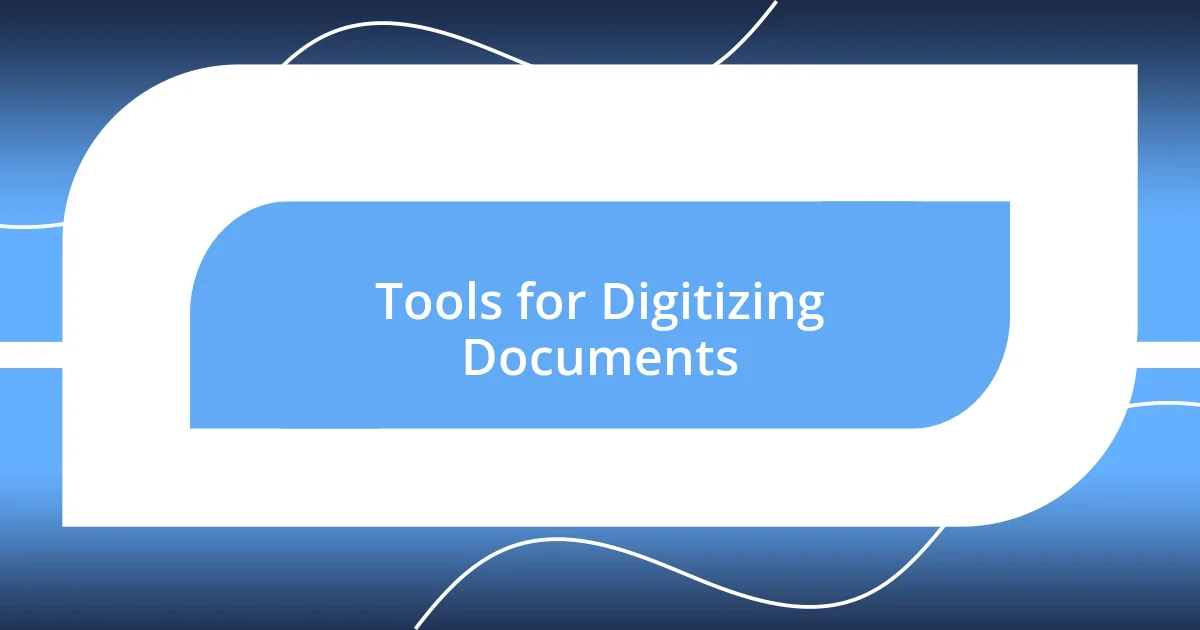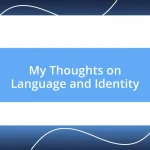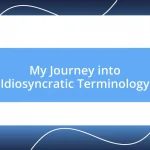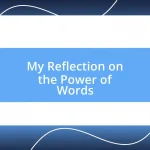Key takeaways:
- Exploring old texts reveals emotional connections and societal contexts, enhancing understanding of historical experiences.
- Employing various text analysis methodologies (thematic, content, narrative, etc.) enriches the engagement and interpretation of historical writings.
- Preservation efforts, including digitization and proper storage techniques, are crucial for ensuring future access to important cultural narratives and memories.

Understanding Historical Context
Understanding the historical context of old texts is like uncovering layers of an onion. When I first stumbled upon a collection of letters from the 19th century, I was struck by their raw emotion and the circumstances that shaped their authors. It made me wonder: how often do we overlook the personal stories behind the words?
Each document I explored became a portal into its time, revealing social norms, political struggles, and cultural beliefs that were once taken for granted. For instance, discovering how women communicated their desires and fears during a patriarchal era opened my eyes to their resilience. It’s fascinating to consider how such texts reflect not just individual experiences but the collective psyche of an entire period.
I remember feeling a rush of excitement as I deciphered a handwritten diary from a soldier during a major war. The mundane details of his daily life contrasted sharply with the historical events unfolding around him. It raises a compelling question: in what ways do our current writings reflect our own social realities? Understanding this context isn’t just academic; it’s a deeply emotional journey that breathes life back into the past.

Types of Old Texts Explored
Exploring old texts opens a treasure chest of various genres and types. For instance, I’ve come across ancient manuscripts filled with poetry that spoke to the universal nature of love and loss. Each verse resonated with my own experiences, proving that the human heart transcends time. Old letters, on the other hand, offer intimate glimpses into personal lives, like a time capsule of emotions and daily struggles. I recall reading a soldier’s letter home, vividly feeling his longing and fear, which bridged the gap between our worlds.
When sifting through historical accounts, I was often surprised by the observations they provided on societal issues. One particularly gripping memoir recounted the challenges faced by a family during a famine, allowing me to understand the stark realities others have endured. This emotional connection made the text more than just words on a page; it transformed it into a narrative that sparked empathy and reflection.
Another fascinating type of text I explored was legal documents from centuries past. Reading through these papers, I felt a mix of curiosity and respect, as they illuminated the evolution of law and society. I remember the thrill of discovering laws that once governed everyday life, pondering how far we’ve come and how many layers still exist. Engaging with these texts felt like holding hands with history, a dialogue across time that is both humbling and enlightening.
| Type of Text | Key Insights |
|---|---|
| Poetry | Reveals universal emotions, linking past and present experiences. |
| Letters | Offers personal narratives, providing intimate insights into individual lives. |
| Historical Accounts | Highlights social issues, fostering empathy and understanding. |
| Legal Documents | Illuminates the evolution of law, showcasing societal progress. |

Methodologies for Text Analysis
When diving into text analysis, I find that employing various methodologies can significantly enhance my understanding of the material. One basic approach is to use a thematic analysis, where I identify patterns and themes within the text. I vividly recall analyzing a collection of speeches; the recurring themes of hope and resilience struck a deep chord with me, reminding me of the challenges we face today. In contrast, a more quantitative method like textual analysis allows me to uncover word frequencies and trends that might not be immediately apparent.
Here are some popular methodologies for text analysis:
- Thematic Analysis: Identifies patterns and themes within the text to uncover deeper meanings.
- Content Analysis: Focuses on the frequency of specific words or phrases, revealing trends in language over time.
- Narrative Analysis: Examines the structure of stories within texts, helping frame personal experiences in context.
- Discourse Analysis: Explores how language shapes and reflects social norms, providing insight into cultural perspectives.
- Comparative Analysis: Involves juxtaposing different texts to uncover contrasting themes or viewpoints, adding layers of understanding.
Using these methodologies not only enriches my experience with old texts but it also allows me to connect with authors on a more profound level. When I was analyzing a set of early 20th-century literary critiques, I was intrigued by how the authors expressed disappointment and hope about societal shifts. It felt strikingly relevant as I considered the challenges of my own era, allowing me to immerse myself in their struggles. Engaging with these analytical frameworks helps me to understand more than just the text itself; it opens a dialogue with the past that resonates within my present.

Tools for Digitizing Documents
Digitizing old documents has become an essential part of preservation. I remember when I first tried to digitize some fragile family letters. I was thrilled by how quickly a scanner could turn yellowed pages into crisp digital copies. It felt like a little victory, knowing that these memories would be safeguarded for future generations.
In my experience, software like Adobe Acrobat is invaluable for editing and organizing scanned documents. I’ve spent hours enhancing the readability of faded texts, and it’s incredible what a little contrast adjustment can do. Have you ever tried to read a document where the ink has all but vanished? Enhancing those images not only brings them back to life but also helps me engage with the story behind the words.
Another tool that I found surprising is Optical Character Recognition (OCR) software. Using OCR, I can turn those scanned images into editable text, which has made my research so much easier. I still recall the excitement when I transformed a 100-year-old recipe into a modern format for my cooking blog. It felt like I was not just sharing a dish but also a piece of my family’s history. What tool will you use on your next digitization project? Each choice can make a significant difference in how you preserve and interact with the past.

Identifying Authenticity in Texts
One of the most rewarding aspects of exploring old texts is determining their authenticity. I once came across a 19th-century letter that claimed to be from a notable author, but something felt off. Examining the ink and paper, I discovered inconsistencies in the handwriting that led me to question its legitimacy. This experience taught me the importance of scrutinizing physical characteristics, like the type of ink used or the texture of the paper, as these details often reveal a text’s true origins.
In my journey, I’ve learned to pay close attention to contextual clues as well. For instance, an old diary entry might reference specific events or figures that can establish a timeframe. I recall getting excited when I matched references in a journal to historical events; it felt exhilarating to peel back the layers and uncover the voice of the past. Have you ever stumbled upon a text that seemed to resonate with personal connections to your own history? Those alignments can illuminate the authenticity of a piece and deepen our understanding of our own narratives.
Moreover, collaborating with experts has been invaluable in this quest for authenticity. I once attended a workshop where a historian shared techniques for analyzing stylistic elements in texts. This sparked my curiosity and opened my eyes to nuances I had never considered before. Surrounding myself with knowledgeable individuals not only enriched my understanding but also reinforced the idea that authenticity often lies in a collective pursuit of knowledge. What insights have you gained from others that helped clarify the authenticity of historical texts you’ve encountered?

Cultural Insights from Old Texts
Old texts often serve as windows into cultures long gone, revealing social norms, values, and traditions. I recently read an ancient manuscript that depicted daily life in a 16th-century village. The descriptions of harvest festivals and communal gatherings struck a chord with me, making me reflect on how similar festivities resonate in today’s societies, despite their evolution over time. Have you ever stumbled upon a tradition that felt oddly familiar yet different? This connection illustrates how cultural threads weave through generations, shaping our collective identity.
In another instance, I uncovered a collection of folktales that had been passed down through oral tradition. The themes of bravery, love, and morality in these stories seemed universal, transcending the specific cultural context. I felt a deep sense of belonging as I recognized these common narratives—a reminder that storytelling is a fundamental part of what makes us human. It’s fascinating to think how these tales have shaped the values of their respective cultures, don’t you think? I was inspired to share my own family stories, realizing that every culture, including my own, carries rich narratives waiting to be told.
Diving into old texts also illuminated the power of language and its evolution. I remember skimming through a translation of classical poetry and feeling struck by how the same words could evoke fresh emotions across centuries. Discovering the subtleties in idioms and expressions from different eras has given me a newfound appreciation for linguistic heritage. Have you ever encountered a saying that made you ponder its origins? Exploring the etymology of words not only deepens our understanding of language itself but also highlights the ever-changing human experience.

Preserving Old Texts for Future
Preserving old texts is essential for ensuring that future generations can access and learn from our shared history. I recall a visit to a local archive where I saw a dedicated team restoring 18th-century books. The meticulous care they took—every tear, every fading page—highlighted not just the physical aspects of preservation, but also the emotional significance behind those texts. It made me wonder, how much of our collective memory relies on these fragile documents?
In my experience, digitizing old texts has become a vital aspect of preservation. For instance, I once participated in a project to scan and catalog a series of rare manuscripts. This effort opened my eyes to the delicate balance of technology and tradition. The thrill of making these texts accessible online made our local history feel alive and attainable. Isn’t it fascinating to think how, with just a click, anyone can now explore the thoughts and experiences of people from centuries ago?
Moreover, I learned that environmental factors play a crucial role in the preservation process. During my studies, I encountered various preservation techniques involving humidity, light control, and temperature regulation. At one point, I volunteered at a conservation lab where I witnessed firsthand how improper storage could deteriorate irreplaceable texts. This realization filled me with a sense of urgency; how many stories could be lost if we don’t take action now? It’s a reminder that the stewardship of our literary heritage is a responsibility we all share.












